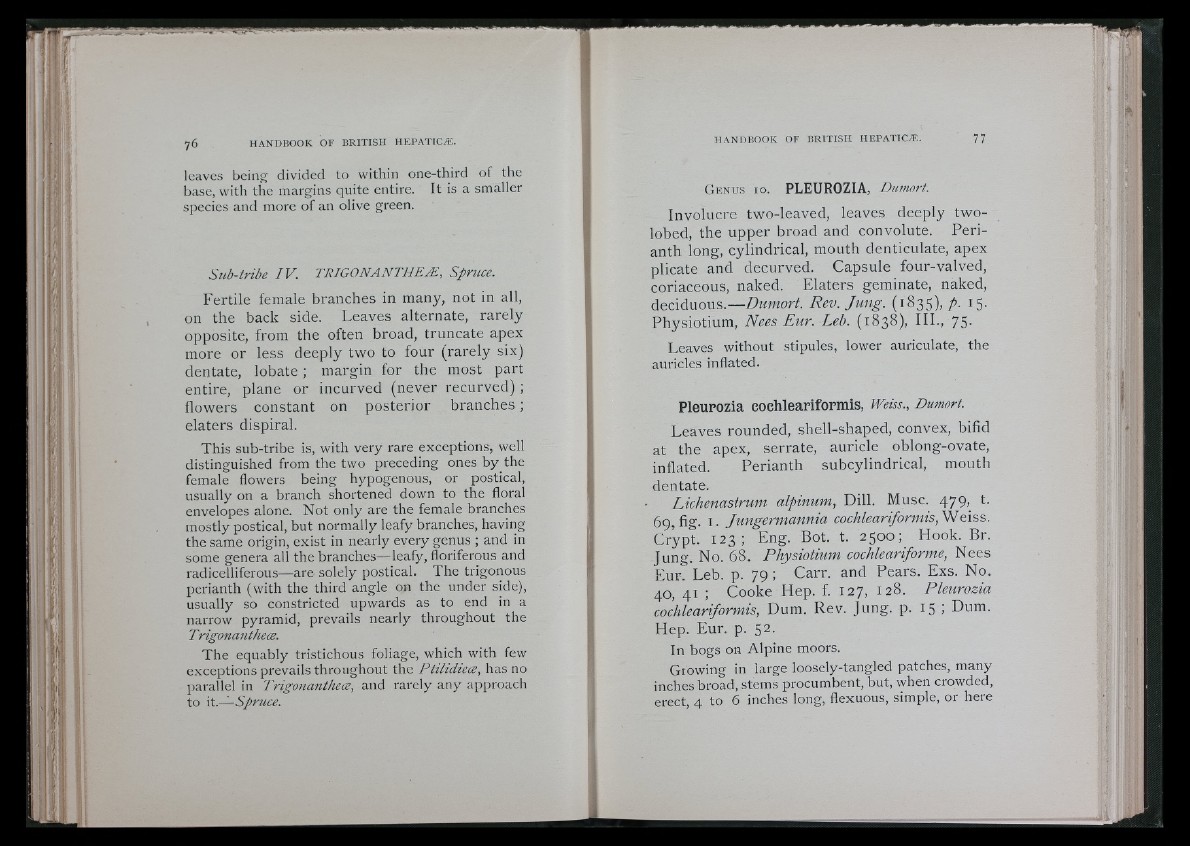
/il.
I:
a;
leaves being divided to within one-third of the
base, with the margins quite entire. It is a smaller
species and more of an olive green.
Sub-tribe IV . TRIGONANTHEÆ, Spruce.
Fert ile female branches in many, not in all,
on the back side. Lea v e s alternate, rarely
opposite, from the often broad, truncate apex
more or less de eply two to four (rarely six)
dentate, lobate ; margin for the most part
entire, plane or incurved (never recurved) ;
f lowers constant on poster ior branches ;
elaters dispiral.
This sub-tribe is, with very rare exceptions, well
distinguished from the two preceding ones by the
female flowers being hypogenous, or postical,
usually on a branch shortened down to the floral
envelopes alone. Not only are the female branches
mostly postical, but normally leafy branches, having
the same origin, exist in nearly every genus ; and in
some genera all the branches— leafy, floriferous and
radicelliferous— are solely postical. The trigonous
perianth (with the third angle on the under side),
usually so constricted upwards as to end in a
narrow pyramid, prevails nearly throughout the
Trigonantheæ.
The equably tristichous foliage, which with few
exceptions prevails throughout the Ptilidieæ, has no
parallel in Trigonantheæ, and rarely any approach
to \t.— Spruce.
G e n u s i o . PLEUROZIA, Dumort.
Involucre two- leaved, leaves deeply two-
lobed, the upper broad and convolute. P e r i anth
long, cylindrical, mouth denticulate, apex
plicate and decurved. Capsule four-valved,
coriaceous, naked. Elaters geminate, naked,
deciduous .— Dumort. Rev. Ju n g . (1835), p. 15.
Physiot ium, Nees E u r . Leb. (1838), III., 7 5 -
Leaves without stipules, lower auriculate, the
auricles inflated.
Pleurozia coehleariformis, Weiss., Dumort.
Le a v e s rounded, shell-shaped, convex, bifid
at the apex, serrate, auricle oblong-ovate,
inflated. Perianth subcylindrical, mouth
dentate.
Lichenastrum alpinum. Dill. Muse. 479» t.
69, fig. I. Jungermannia cochleariJormis,WViss.
Crypt . 1 2 3 : Eng. Bot. t. 2500; Hook. Br.
Jung. No. 68. Physiotium cochlearijorme, Nees
Eiur. Leb. p. 7 9 ; Carr, and Pears. Exs. No.
40, 41 ; Co o ke Hep. f. 127, 128. Pleurozia
coehleariformis, Dum. Rev. Jung. p. 15 i Dum.
Hep. Eur. p. 52.
In bogs on Alpine moors.
Growing in large loosely-tangled patches, many
inches broad, stems procumbent, but, when crowded,
erect, 4 to 6 inches long, flexuous, simple, or here
1